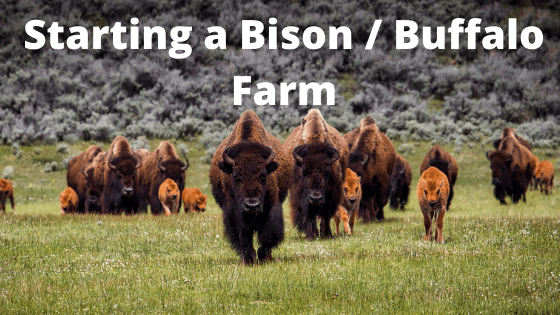Starting a Commercial Buffalo Farm. Increased urbanization, an increase in the population, and a changing food pattern have increased the demand and consumption of milk and meat in urban areas.
If you are interested in commercial buffalo farming or you are thinking about bison farming and you want to know about the selection of animals, feeding guidelines, and their management
Then this post is especially for you.
Commercial Buffalo or Bison farming is a profitable business. It will help to cope with the increased demand for milk and meat in urban areas. Buffalo Farm
Commercial farming of buffalo and bison is actually about good management and common sense. This industry can and will reward producers with a reasonable return.
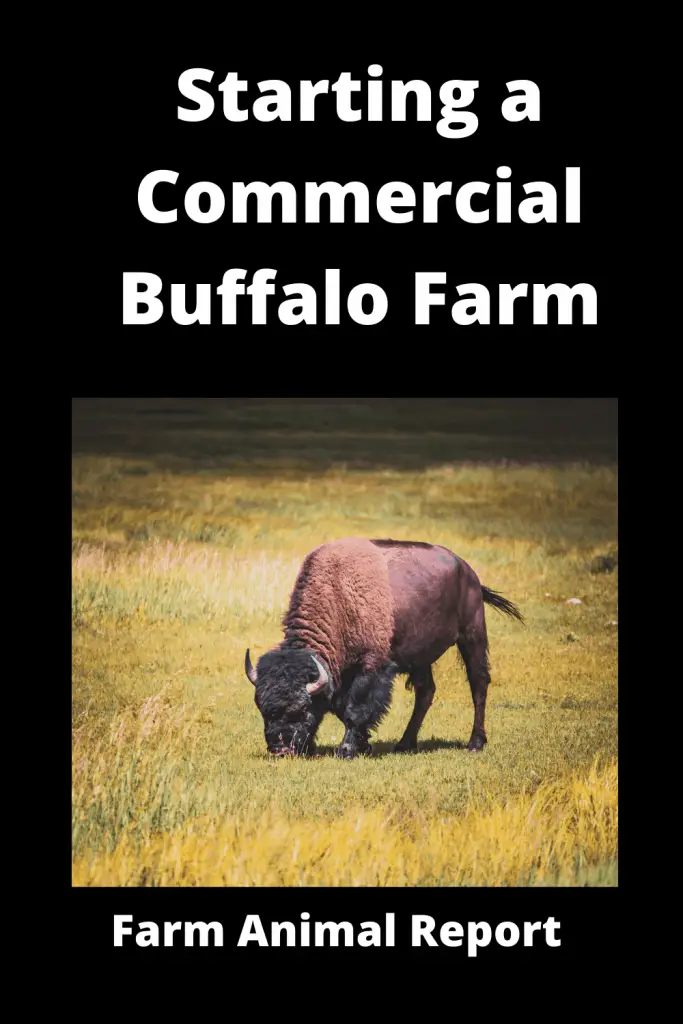
It is important to mention that for any successful commercial farming, you must learn and understand the basics of management such as feeding, health conditions, breeding, etc
First of all, it is very important to know the difference between Buffalo and Bison.
Starting a Commercial Buffalo Farm / Difference between Buffalo and Bison
People usually think that bison and buffalo are the same, they are not the same Bison and buffalo are related in the sense that they are members of the same family.
Both animals belong to the Bovidae family as do other animals like the musk oxen and domestic cattle.
The bison and the buffalo have many things in common but there are some differences between the Bison and buffalo.
Buffalo
The buffalos have two main categories and these are the Water Buffalo and the Cape buffalo.
The water buffalo is also called the domesticated Asian Buffalo and it is found in Asia, North Africa, and Southern Europe.
The Cape buffalo is found in the grasslands of sub-Saharan Africa and it is also called “Syncerus caffer”.
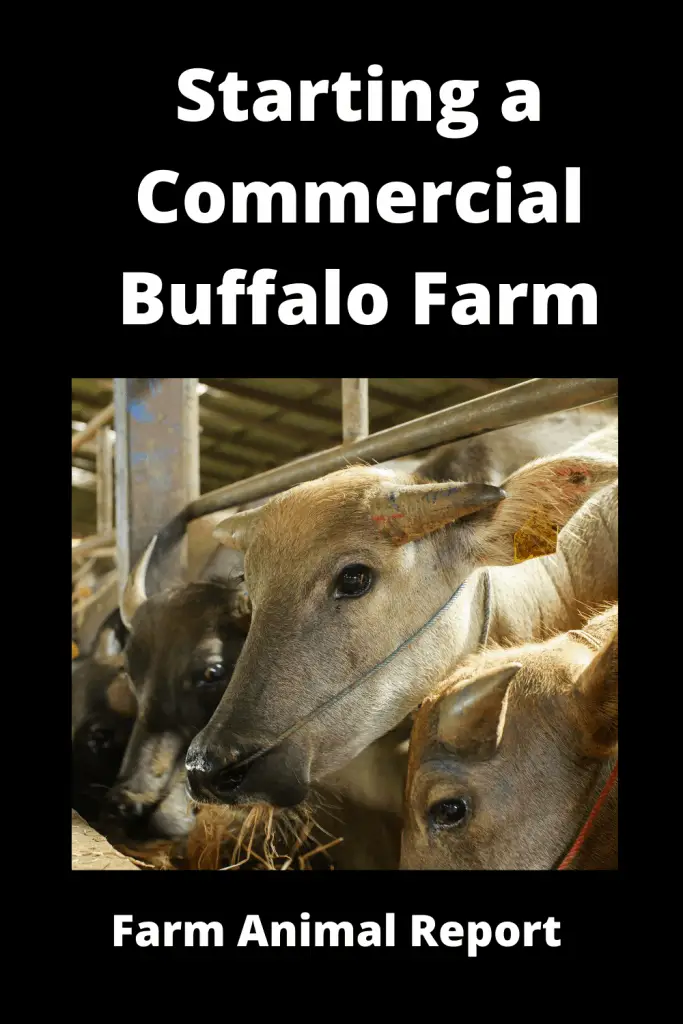
Bison
But the natural habitat of the bison covers most of the United States, southern Canada, and northern Mexico.
The two most popular categories of bison are the Wood Bison and the Plains Bison.
As stated already both animals are bovids but there are differences in physical appearance. Generally, the buffalo has a larger body than the bison.
The buffalo also has a bigger horn and a much bigger head than the American bison. The buffalo also has a smooth coat while the bison has a shaggy winter coat.
The bison has short and stocky legs, a short horn and a hump on its back. Buffalo are kept for milk production but Bison are kept for meat production.
Commercial Farming of Buffalo
Commercial farming of buffalo and bison is different from each other in terms of management and rearing. So firstly we will discuss the commercial aspects of buffalo farming.
Farming of Buffalo is not a new concept in the new world. Wild water buffalo have domesticated in the Indian subcontinent about 5,000 years ago, and about 4000 years ago in China.
Buffalo farming business is similar to starting a cattle farming business. Most of the time, the buffalo are raised by farmers who work on small farms in family units.
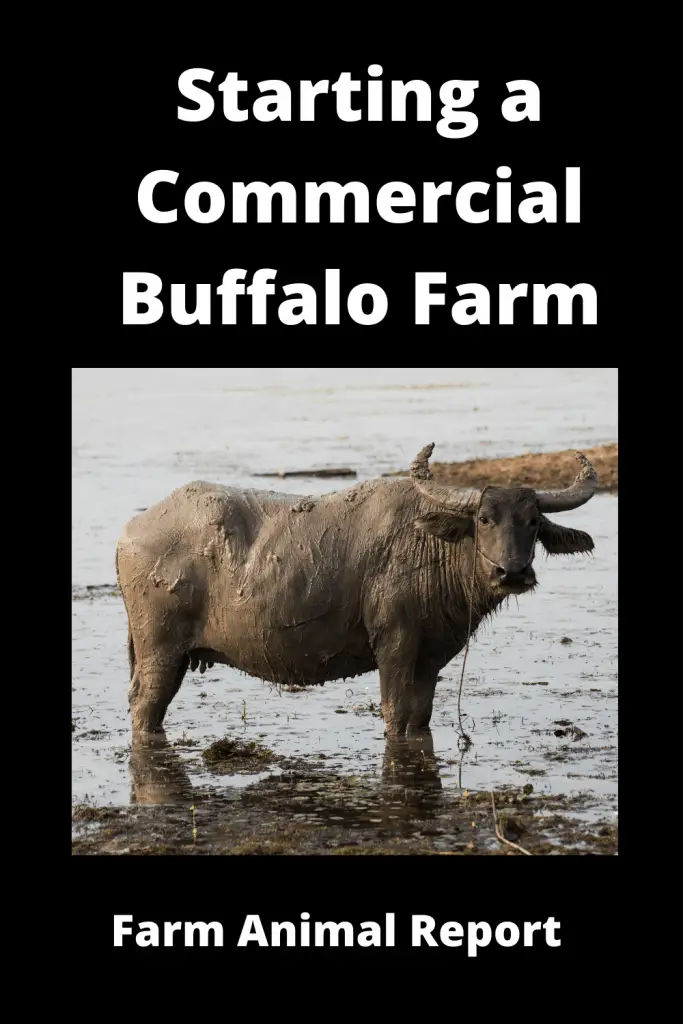
Their buffaloes often live in very close association with them, often with their other largest animals.
Buffalo is often referred to as the “living tractor of the East.” It is the most efficient and economical way to grow small fields.
But after the modernization of agriculture, Using Tractors, the uses of buffaloes largely reduced. Currently, buffalo is being raised for milk or meat. However, here we will describe how to do buffalo farming.
A first and most important step of starting a farming business is
Selection of Suitable area
The following important factors must be considered for the selection of a site for a Buffalo dairy farm:
- The dairy building should be at a higher altitude than the surrounding land to provide a good slope for drainage of dairy waste and rainfall water.
- The soil must be fertile because it is necessary for growing fodder.
- For selection, it should also be remembered that the dairy building should have the maximum exposure to sunlight and should be protected from the prevailing strong air currents, whether hot or cold.
- The building of your dairy farm should be easily accessible. So the building of dairy farms should be located near the road.
- There should be an abundant supply of fresh, clean and soft water on your farm.
- It should be kept in mind that the area is safe from wild animal
- Dairy buildings should only be in those areas from where you can sell dairy products profitably and regularly.
- There should be a regular supply of electricity on a dairy farm.
Selection of Types of Buffalo:
Success of your buffalo farming business depends on selecting good quality breeds. Select good breeds depending on your production purpose.
Some well known and popular buffalo breeds are
- Murrah
- Surti
- Jafarabadi
- Anatolian
- Nili-Ravi
- Egyptian
- Mediterranean
- Pandharpuri
- Nagpuri
- Romanian buffalo
You should select and purchase buffalo breeds depending on the availability in your area.
Purchasing of Animal
First of all, it needs to be decided which breed of animal you prefer. For the selection of breed keep in mind the following characteristics of a good breed:
- Animals that attain maturity at an early age
- First calving and first lactation should be at an early age
- More production per lactation
- Less calving interval
- Short dry period
- Short service period
- Less feed intake and more production (Better FCR)
- Try to purchase young animals, recently calved and preferably in the second lactation.
- Make sure that animal is disease-free.
- Carefully examine the udder including the teats. After milking, the udder should shrink like a balloon from which air blows out.
- The teats should be properly placed and of moderate size. There should be no extra teats
- To determine the daily milk yield, the animal should be milked for three consecutive milkings. This also helps find out the temperament of the animal.
- Make the animal move a few steps to assess if there is any leg problem.
- Also, check that the animal has healthy eyes.
- The dairy animal should not be abnormally over or under conditioned.
- Better watch the animal while it is ingesting feed. Possibly, examine its teeth and observe that it ruminates well.
- Only high producing animals should be selected.
Keep the newly purchased animals separate and away from the already eating stock for at least 3 weeks to make sure that they do not have any disease problems.
You should always ask the owner which method of breeding was used (Artificial insemination or natural service) so that in the future you can decide easily.
You should also ask the previous owner about vaccinations done and about the diseases that commonly are so that preventive measures can be taken.
Provide almost the same feed to the animals in which they were being fed by the previous owner and if need be, change the feed gradually over a period of 10-14 days so that production is not affected. That way you won’t create unnecessary diarrhea
Find out the brand mark or some other mark of identification of the animal and also make sure about the ownership of the animal. The deal should be documented and signed.
Feeding guidelines for Commercial Buffalo Farming – During Milking
The main diet for the buffalo is roughage such as grass, legumes, and straw. The roughage can be fed either fresh as pasture or in a cut-and-carry system or conserved as hay or silage.
Roughages should form the basis of the feeding ratio and contribute to meeting the total maintenance requirements.
Grains and concentrates should only be fed to meet additional requirements such as growth, pregnancy, and milk production.
Dairy buffalo nutrition varies with phases of lactation and gestation. The lactation period of dairy buffalo is divided into five phases:
Phase 1 – Early Lactation
This is phase of early lactation consists of early 70 days postpartum. This is the period during which milk production increases rapidly, peaking at 6 to 8 weeks after calving.
During this phase, nutrient requirements are not fulfilled because feed intake does not keep pace with nutrient needs for milk production, especially for energy, and body tissue will be mobilized to meet energy requirements for milk production.
Ration adjustment is an important management practice during early lactation.
Phase 2 – Peak Lactation
This phase is from 70 to 140 days postpartum during which the animal reaches peak DM intake.
During this phase animal is at its peak production and this production should be maintained as long as possible. The animal should be provided high-quality forage along with concentrate.
Phase 3 – Declining Lactation
This period is of mid to late lactation i.e. 140 to 305 days postpartum. During this phase, milk production is declining and the buffalo is pregnant.
The animal requires nutrients for milk production and replace body weight lost during early lactation. Lactating buffalos require less feed to replace a pound of body tissue than dry buffalos.
Young buffalos should receive additional nutrients for growth.
Phase 4 – Dry – No Milk
Phase 4 is a dry period that covers 60 to 14 days before parturition. This is a critical phase of the lactation cycle.
A good, sound nutritional management during this phase may lead to high milk yield during the following lactation and minimize metabolic problems at or immediately after parturition as the animal is preparing for next lactation during this phase.
Phase 5
This period is called the transition period or close-up period which includes the last two weeks of parturition.
Nutritional requirements for fetal growth are higher during this phase. Good nutritional planning is required during this phase to get high milk production after parturition.
Breeding of buffalo
The breeding of buffalo is one of the most important factors of a profitable farm. Swamp buffaloes generally become mature and start breeding at an older age than the river buffalo breeds.
The young males generally mate first within 3-3.5 years of age. Male successful reproductive behavior may continue until the animal is 12 years of age or older.
Generally, good and healthy males (Bulls) can impregnate 100 females a year.
The reproductive efficiency of buffaloes shows wide variation throughout the year. Females show a distinct seasonal change in displaying oestrus, pregnancy rate, and birth rate.
Depending on the breed, the age at the first oestrus of the buffalo is from 24 to 36 months.
Mating in the first oestrus cycle is usually infertile and is generally postponed until 3 years of age. Buffalo pregnancy (Gestation) generally lasts from 281 to 334 days.
Swamp buffalo carry their calves for a longer period, than river buffalo. The average life of buffalo can be up to 18-20 years.
Management of Milking Buffalo in Commercial Buffalo Farming
In order to obtain high milk during the lactation period, the milking animal must be properly fed and the necessary care and management mental practices should be followed.
The animal must be provided with high-quality silage or hay. An additional concentrate of 1 kg per 2 liters of milk should be provided. Salt and minerals should be supplemented.
Do not frighten or excite animals. Always treat them kindly and courteously. Clean fresh water must be available at all times. Lukewarm water is preferred in severe winters.
You should milk animals at regular times. If we change the time or interval, production declines. There should be an interval of 8-14 hours. Milking should be done quickly.
Do not leave the milk in the udder. Otherwise, it will decrease milk in the next milking.
Increasing the frequency of milking twice a day to three times per day may increase your milk production by 2.5 to 3.5 liters per day.
Milking Machines are the same used for Cattle – Just some different Procedures
Buffalo must be bred up to 60 days after calving for the next calf. For this purpose proper heat detection is required.
Record Keeping
Without record keeping, successful commercial buffalo farming is not possible. Different types of records which should be kept at commercial buffalo farm are:
- Record of buffalo Strength with their age, Sex, Date of Birth, Date of purchase, etc.
- Breeding Record
- Production Record
- Calf Record
- Feeding Record
- Health Record
- Mortality Record
- Sale Record
- Expenditures and Profit Record
- Manpower Record
Common Health problems in Commercial Buffalo Farming
In commercial buffalo farming different bacterial, viral, protozoal, fungal and endoparasitic pathogens can infect the buffaloes worldwide.
Bovine leptospirosis
It can result in important economic losses due to reproductive wastage. Infection on pregnant females often leads to abortion and other neonatal diseases that can be caused by intrauterine infections during the last trimester of gestation
Brucellosis
Brucellosis in buffalo is acknowledged as a contagious infectious disease.
Brucellosis has a huge economic impact on livestock species, especially in developing countries due to reproductive problems, low milk production, and restrictions on animal movements and trade.
It is characterized by abortion, predominantly in the last trimester of gestation, premature births followed by retention of placenta, non-viable calves, infertility, reduction of milk production, and lameness.
Bovine ephemeral fever
Bovine ephemeral fever is an economically important disease affecting cattle, yak and water buffalo among other ruminants.
Bovine viral diarrhea
Bovine viral diarrhea virus is another significant pathogen causing respiratory and reproductive illnesses infecting ruminants that lead to various clinical problems including abortion.
Trypanosomiasis
It is also known as Surra. It is a blood and occasional tissue parasite to a variety of animals transmitted by biting flies cause chronic wasting leading to abortion and death
Preventive measures
Prevention is better than cure. Here are some preventive guidelines to prevent diseases
- The premises and pastures should be prevented from contamination.
- Elimination of parasites from the buffalo at the most appropriate time by use of antiparasiticides thereby preventing pasture contamination.
- Destruction of adult parasites in buffalos prevents the expulsion of eggs or the larvae and the associated contamination of the environment.
- Reducing the stocking rate can significantly reduce the parasite burden in animals and the associated problem of contamination in sheds and pastures.
- Reduction in the number of snail intermediate hosts by drainage, fencing, and other management practices.
- Ridding the animal of internal parasites by periodical deworming,
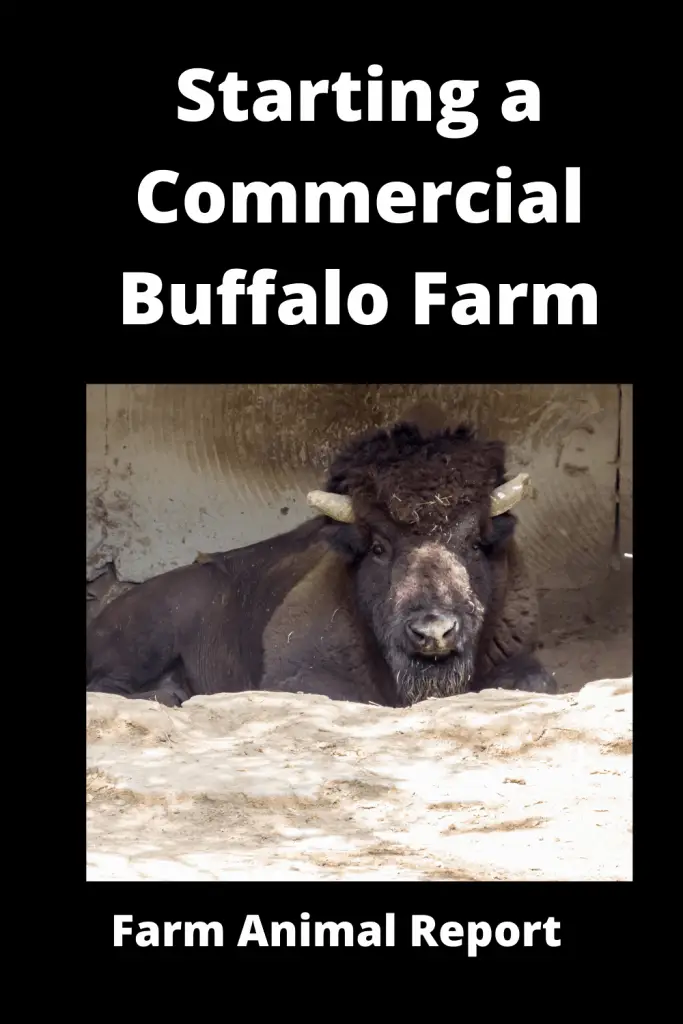
Products and uses
Commercial buffalo farming is good for producing many types of milk, meat, and skin products. But mostly buffalo is used to produce dairy products.
Buffalo milk is of very good quality contains large amounts of fat and protein. Milk is generally used in making butter, ghee, fermented milk products, whey, soft cheese, hard cheese, yogurt, etc.
Commercial Bison Farming
The commercial bison farming sector is part of the agricultural industry. It is a meat-based industry. It is very different from commercial buffalo farming due to many reasons.
In fact, to run a herd of bison, you have to become almost one of the herds. By learning about the situation, and understanding the different guttural sounds and sign language, you will be able to interact with your animals without a problem.
Bison farming is very easy if you remember this saying, “you can lead a bison anywhere it wants to go”.
Beginning / Starting a Bison Farm
If you want to start a Bison farm, if possible before purchasing any animal, observe several herds and visit farm sales and auctions.
The best strategy is usually to start small and grow. Raising bison is similar, but not identical, to raising beef cattle.
Bison are larger, stronger, and more excitable than cattle and thus require special fencing and handling facilities.
Because bison is still considered a wild animal, you should plan a strong corral-chute system appropriate for your location and expected herd size.
Fencing – Strong and Electric
If you are trying to rear bison one thing you should keep in mind they can jump fences and breakthrough almost any barrier, a strong containment system is essential.
The fences surrounding the pasture must consist of eight high-tensile wires, three of which carry a high voltage current.
It is recommended to use the corral-chute system with no sharp turns or corners with sides from 7 to 8 feet high.
The system should include walkways, fodder bunkers, water, lighting, a large area for each animal, and spring-mounted matrix gates. Crowded circles, alleys and sorting pens are essential.
Ideal land for bison would have boulders, rocks, rugged areas, woods, and thickets, but the only requirements are adequate pasture and a water source.
Running water is preferable, but a pond will suffice. If you satisfy a bison’s food and water requirements, it will stay within the fenced area. Otherwise, almost no barrier can stop a hungry bison.
Breeding of Bison
Mature bison range in weight from 1,000 to 1,500 pounds, reaching peak physical maturity at 8 to 10 years old. They can live for 30 years or more.
With good management, bison can breed every year and can start to breed at two years of age.
The normal gestation period is 280 to 285 days. The breeding season begins in August and continues into October, while the calving season begins in May and continues into July.
Bulls weigh about 2,000 pounds at maturity and can be used for breeding at two years of age. One bull can breed 10 to 15 females.
You can try artificial insemination, but natural breeding methods are safer due to the unexpected mood of bison and the scarcity of semen.
To prevent inbreeding and to improve the herd, new young bulls must be brought to the herd every two or three years.
Feeding Requirement of Bison
In the farming industry of bison, the food sector consists of two parts. One of them is breeding and replacing the herds that are grass grazers.
The second part is the feedlot. The feedlot requires extensive management design and food rations that ensure growth, condition, and finish.
The winter feeding program differs from region to region. It may consist of swath grazing.
The trick in bison feeding is to realize the value of feed base fees and balance your stake with enough energy and minerals. A program of this type guarantees performance and is cheaper.
In the wild, bison eat twigs, leaves, and grasses. An intensive grazing program will help you make the most use of your pasture.
Bison continue to graze through the winter by rooting under the snow.
Grasses that stand up through the snow and retain a high protein percentage in the stems are best for winter pasture.
Hay should be available when the snow is coated with ice. Grain rations should be included in the winter or when pasture conditions are poor.
The key to good bison performance is the development of alternative heifers. Mother’s buffalos look after their calves for five months or six months.
The rest is your responsibility. At this age, these heifers cannot consume enough straw to maintain adequate growth.
At one year of age, the decision to continue feeding supplements depends on the quality of pasture and quality of roughage to be fed the following winter. The mineral and slat program must continue.
Salt, vitamins, and minerals should be added to the diet as needed. The extra nutrition gained from supplements increases reproductive efficiency and weight gain.
Selenium is especially important for reproduction because a deficiency of this mineral causes an increased number of aborted calves.
Whatever you do, do not skimp on feed. Keep the feedthrough full and maintain at least a 19% roughage in the diet.
Supply a good source of freshwater to finalize your feedlot ration. Water can be and often is the reason animals do not gain.
Health Conditions in Bison
Diseases of Bison
Many diseases are known to occur in bison but very less data is available not because bison have more resistance to disease than other species but because of the minimal amount of research.
Here are some diseases present in bison such as:
- Malignant Catarrhal Fever (MCF) in Bison
- Anaplasmosis in Bison
- Anthrax
- Mycoplasma Disease in Bison
- Miscellaneous Localized Infection (Abscesses)
- Actinobacillosis
- Blackleg
- Brucellosis
- Foot Rot
- Hemorrhagic Septicemia
- Histophilosis
- Johne’s Disease
- Leptospirosis
- Listeriosis
- Pinkeye
- Bovine Tuberculosis
- Bovine Virus Diarrhea (BVD)
Preventive measures
The lack of available information makes identifying and treating diseases in bison herds challenging for both veterinarians and producers
The key to a healthy farm is good health programs and preventive medicines. In bison, this means good nutrition, clostridium vaccination, a deworming program, and a stress-free environment.
Bison should be on a routine deworming program for tapeworms, roundworms, lungworms, flukes, and other parasitic worms.
The deworming program should be developed with a veterinarian and should take into account climate, regional and farm parasite problems, and grazing intensity.
External parasites, including flies, lice, mites, and ticks, can be controlled with strips, baits, sprays, foggers, dust bags, and liquid products.
Product and uses of Bison farming
Bison are raised commercially for various markets:
- Meat, bones, and hides are sold to restaurants and shops. A growing number of supermarkets are also selling bison meat.
- Both bulls and heifers are sold to other producers for breeding stock.
- Animals are sold for organized bison hunts.
- Bison are sold to public game reserves and zoos.
Conclusion
Buffalo and bison both have their own importance in their sectors. Bison can meet the growing demand for meat production in urban areas.
Buffalo is a good source of milk production due to its adaptation to natural conditions and their ability to benefits from poor feed and turn into milk and meat, People are looking into more and more Bison / Buffalo Farming and Domestication


